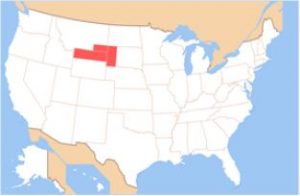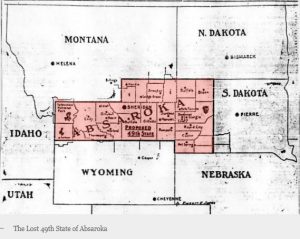 Absaroka…have you ever heard of it? No…I hadn’t either, but it was of some importance to the United States, and it would have been of some significance to me and my family had it not been a temporary situation. You see, when President Franklin D Roosevelt put “The New Deal” in place, there were a lot of people who didn’t think it was such a good deal…much like “The Green New Deal” of today. “The New Deal” was a series of programs, public work projects, financial reforms, and regulations enacted by Roosevelt in the United States between 1933 and 1939. The idea was to “help” by responding to needs for relief, reform, and recovery from the Great Depression. The plan created major federal programs and agencies, including the Civilian Conservation Corps (CCC), the Civil Works Administration (CWA), the Farm Security Administration (FSA), the National Industrial Recovery Act of 1933 (NIRA) and the Social Security Administration (SSA). They provided support for farmers, the unemployed, youth, and the elderly. The New Deal included new constraints and safeguards on the banking industry and efforts to re-inflate the economy after prices had fallen sharply. The New Deal programs included both laws passed by Congress, as well as presidential executive orders during the first term of the presidency of Roosevelt.
Absaroka…have you ever heard of it? No…I hadn’t either, but it was of some importance to the United States, and it would have been of some significance to me and my family had it not been a temporary situation. You see, when President Franklin D Roosevelt put “The New Deal” in place, there were a lot of people who didn’t think it was such a good deal…much like “The Green New Deal” of today. “The New Deal” was a series of programs, public work projects, financial reforms, and regulations enacted by Roosevelt in the United States between 1933 and 1939. The idea was to “help” by responding to needs for relief, reform, and recovery from the Great Depression. The plan created major federal programs and agencies, including the Civilian Conservation Corps (CCC), the Civil Works Administration (CWA), the Farm Security Administration (FSA), the National Industrial Recovery Act of 1933 (NIRA) and the Social Security Administration (SSA). They provided support for farmers, the unemployed, youth, and the elderly. The New Deal included new constraints and safeguards on the banking industry and efforts to re-inflate the economy after prices had fallen sharply. The New Deal programs included both laws passed by Congress, as well as presidential executive orders during the first term of the presidency of Roosevelt.
The New Deal failed because Roosevelt misunderstood the cause of the Great Depression. When a doctor misdiagnoses the symptoms that present themselves, the doctor cannot prescribe the right medicine to cure the disease of a patient. Similarly, Roosevelt prescribed “The New Deal” to cure the economy of the United States from the Great Depression. Roosevelt’s “medicine” did not work because his administration failed to recognize the true causes of the Great Depression and therefore prescribed the wrong medicine. Roosevelt assumed that the free market, and not the government caused the Great Depression. Roosevelt believed the Great Depression was partly caused by poor investments and stock manipulations by rich people. To complicate matters, he blamed the Great Depression on bankers, speculators, and journalists. In reality, the causes of the Great Depression boiled down to three major causes…which explain why there was a banking crisis, why the  stock market declined, why exports vanished, why trading partners were upset, why major industries collapsed, and why there was uncertainty on the administration’s policies. These three explanations of the causes contrast with Roosevelt’s assumption that the private, not the public sector caused the problem. First, the negative consequences of World War I, increasing debt from less than $2 billion to over $20 billion, while at the same time, US loans to Europe amounted to over $10 billion. Second, the Smoot-Hawley Tariff Act…the highest tariff in US history, which affected over 3,000 imported items and even increased taxes on some items. As a result of those high tariffs, foreign goods became less competitive and similar domestic goods more competitive. Third, the Federal Reserve did not prevent a banking crisis, but rather helped cause one. It was argued that the economic contraction was exacerbated because of the bank failures and the massive withdrawals of currency from the financial system while the Federal Reserve did not provide the necessary liquidity that the system required.
stock market declined, why exports vanished, why trading partners were upset, why major industries collapsed, and why there was uncertainty on the administration’s policies. These three explanations of the causes contrast with Roosevelt’s assumption that the private, not the public sector caused the problem. First, the negative consequences of World War I, increasing debt from less than $2 billion to over $20 billion, while at the same time, US loans to Europe amounted to over $10 billion. Second, the Smoot-Hawley Tariff Act…the highest tariff in US history, which affected over 3,000 imported items and even increased taxes on some items. As a result of those high tariffs, foreign goods became less competitive and similar domestic goods more competitive. Third, the Federal Reserve did not prevent a banking crisis, but rather helped cause one. It was argued that the economic contraction was exacerbated because of the bank failures and the massive withdrawals of currency from the financial system while the Federal Reserve did not provide the necessary liquidity that the system required.
As people became more and more agitated about the unsuccessful New Deal, an idea began to form…secession. One of the leaders of the secessionist movement was A R Swickard, the street commissioner of Sheridan, Wyoming, who appointed himself “governor” and started hearing grievances in the “capital” of Sheridan. The new state was to be called Absaroka, which means “children of the large-beaked bird.” They planned secession in 1939. This region largely belongs to the Crow people and the Sioux, according to the Treaty of Fort Laramie (1851). Absaroka is also the namesake of the Absaroka mountain range. The area involved was the entire northern part of Wyoming, the western part of South Dakota, including the Black Hills, and the southeastern corner of Montana. Increasing tourism to the region was a motivation for the proposed state because Mount Rushmore (constructed 1927–1941) would be within Absaroka according to some plans.
The region’s complaints came from ranchers and independent farmers in remote parts of the three states, who  resented the New Deal and Democratic control of state governments, especially the government of Wyoming. In preparation for state secession, state automobile license plates bearing the name were distributed, as well as pictures of Miss Absaroka 1939. The movement was unsuccessful and fairly short-lived. The chief record of its existence comes from the Federal Writers’ Project, which included a story about the plan as an example of Western eccentricity. Oh those eccentric Westerners!! Imagine wanting to limit government, high taxes, and strict laws and mandates!! What were they thinking? Freedom, limited government, capitalism vs socialism…yep among other things, that’s what they were thinking.
resented the New Deal and Democratic control of state governments, especially the government of Wyoming. In preparation for state secession, state automobile license plates bearing the name were distributed, as well as pictures of Miss Absaroka 1939. The movement was unsuccessful and fairly short-lived. The chief record of its existence comes from the Federal Writers’ Project, which included a story about the plan as an example of Western eccentricity. Oh those eccentric Westerners!! Imagine wanting to limit government, high taxes, and strict laws and mandates!! What were they thinking? Freedom, limited government, capitalism vs socialism…yep among other things, that’s what they were thinking.


Leave a Reply